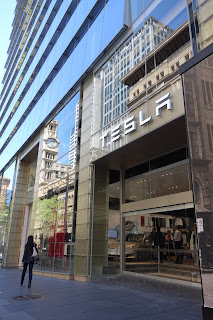Electricity is a beautiful thing. It changed our world during the 20th century, like motorized vehicles also did or like internet is transforming our society. Yet there is one standard which has to evolve about electricity: the storage of it. Today we do not store large quantities of electricity, or only occasionally. Humanity needs to find ways to store large amounts of electricity because in the future more electricity will have to come from solar and wind energy…
THE INTERMITTENCE AFFAIR
 |
| An example of pumped hydro storage on El Hierro island, Spain - This is the superior reservoir of the installation (©AFP). |
Solar and wind are intermittent. They do not necessarily produce the electricity at the moment we need it. Actually solar produces more electricity in the middle of the day and we need it more at the beginning and end of the day. The non-consumed electricity is just lost, except if you store it! In the previous article, we presented an exciting new class of solar cells. Progress in intermittent electricity generation will have to go with progress in storage.
Today the most common technology for storage is pumped hydro storage: pumping water up to a reservoir, and releasing it when electricity is required. The released water goes through a turbine which generates the current, like in a dam. We find such installations in Switzerland or France for instance. But this option has large footprints; it cannot be implemented everywhere. It looks like what we need is efficient batteries…
AND TESLA CAME IN THE GAME
Innovation is giving us new batteries. These batteries will store more electricity and will cost less, together with a very small environmental footprint. They will change the game! Actually the change has started. Big batteries can be installed at your house or at your office building. They store electricity coming from solar panels, for instance, and provide it when you need it. For several years already this home battery has been available for purchase, however the real change has started recently. The Californian company Tesla is helping…
In New Zealand, Vector has installed nearly 200 Tesla home batteries during the last 5 months. Vector is the New Zealand largest distributor of electricity and gas. Several years ago the company decided to lead the switch to the green energy technologies. Since mid 2016 they have started to install the Tesla battery solutions, as the only distributor in New Zealand. We had the opportunity to meet Andrew Fraser who is the New Projects Manager at Vector. Andrew could tell us more about their part in this story.
 |
| We met Andrew at Vector's head office, in Auckland. |
There are two main Tesla products: the Powerwalls and the Powerpacks. The Powerwalls are designed for home; the Powerpacks are designed for businesses or institutions as they offer larger storage capacity. The home Powerwall is dimensioned to meet the demand of a family of four without problem, around 5kWh per day. Most of the time, Vector has provided both the home battery together with solar panels. This is the typical combination.
Andrew explains that recently Rongamai School in South Auckland had a Powerpack installed, together with solar panels, for a four classroom block. The electricity consumption is monitored and the figures are thrilling: 95% of the consumed electricity comes from the solar panels! It does the job.
Vector CEO, Simon Mackenzie, Project Manager Paul Cannin and Minister of Energy and Resources, Hon Simon Bridges, at Auckland Glen Innes power substation (©Vector). On the 20th of October, the Minister opened the first grid-scale battery system installation of Asia Pacific. The substation homes several Powerpacks which will allow the suburb to better face the consumption peaks. The Powerpack is a cabinet containing 16 batteries like the one found in a Powerwall. In a Los Angeles western suburb, a similar project has started recently: the Long Beach facility will host a massive battery storage system.
R&D PEOPLE ARE WORKING HARD ON IT
The year 2016 was a ramp-up for Vector. The distributor sells the "Powerwall and solar panels" package at around 20000NZD (around 13500€), the Powerwall costing around 10000NZD alone. The prices will decrease in the near future together with the growing market, and with innovation. Innovation will allow Tesla and other designers to change the chemistry of the batteries. Also their environmental cost is high today, including the Tesla ones. But it will go down. The Advanced Research Projects Agency-Energy (ARPA-E), in the U.S., is one of the numerous places developing encouraging solutions. One promising battery uses abundant sources such as oil waste or rhubarb. It is much cheaper and less toxic than current batteries.
Solar and wind farms producing and storing electricity will allow using less and less coal and gas power plants. Things will go even further since each building and each house could generate and store electricity. This is just the beginning...
The Sydney Tesla store exhibits the Powerwall.
~~~
In a
2012 article we talked about smart grids in Perth, Australia. Decentralized
generation and storage of electricity will have to go with advanced electricity
distribution grids. This changes the business model of electricity suppliers; they
need to adapt to this switch.
~~~~~~~~~~~~~~~~~~~~~~~~~~~~~~~~~~~~~~~~~~~~~~~~~







No comments:
Post a Comment